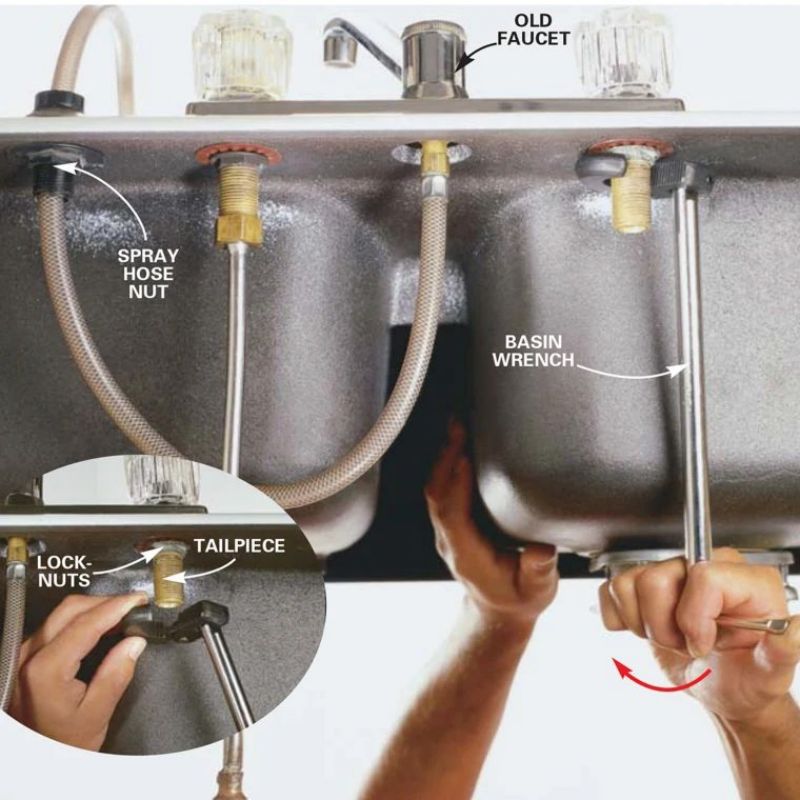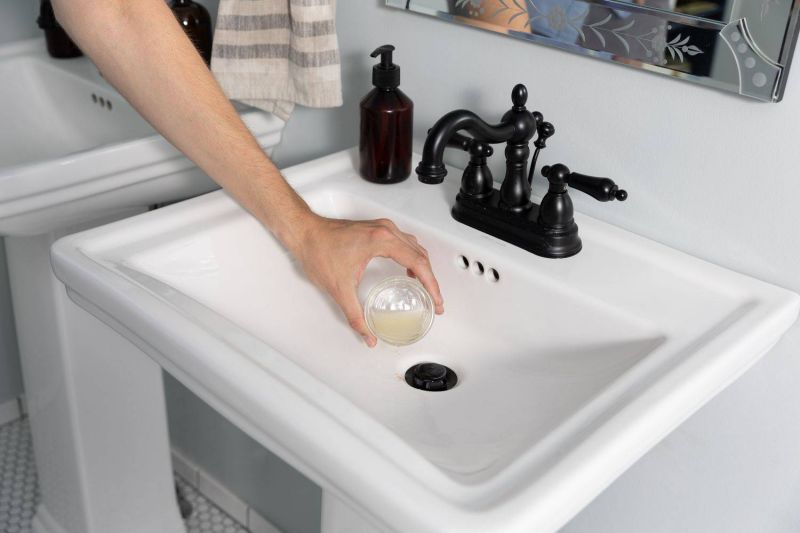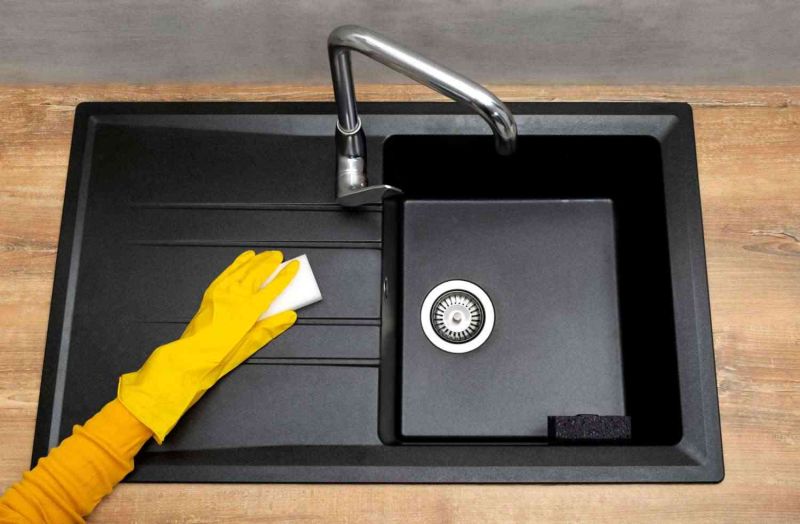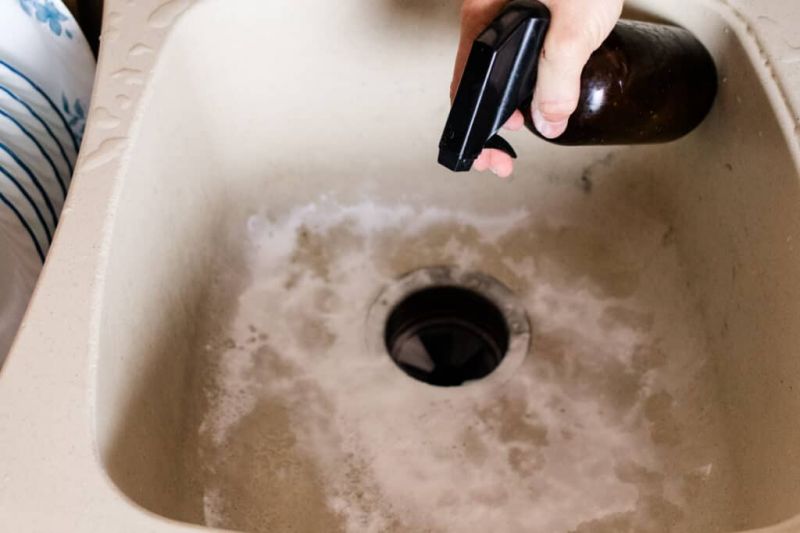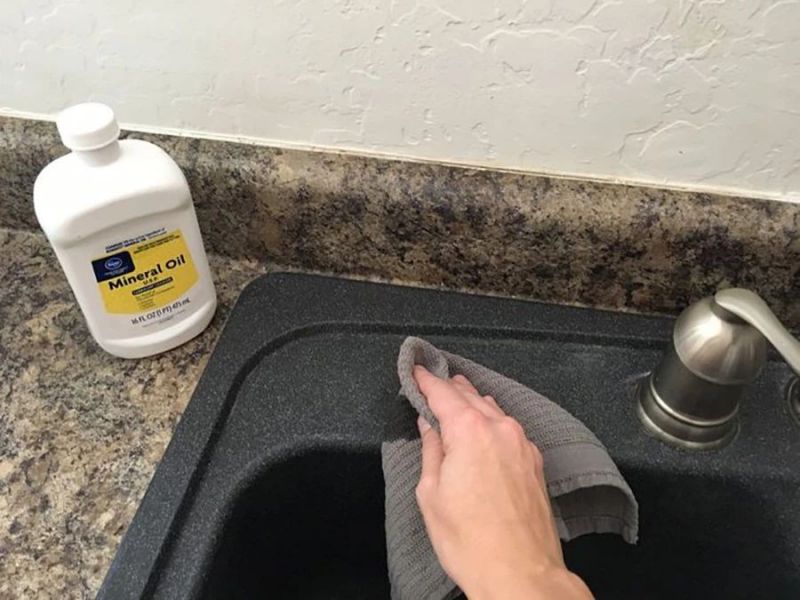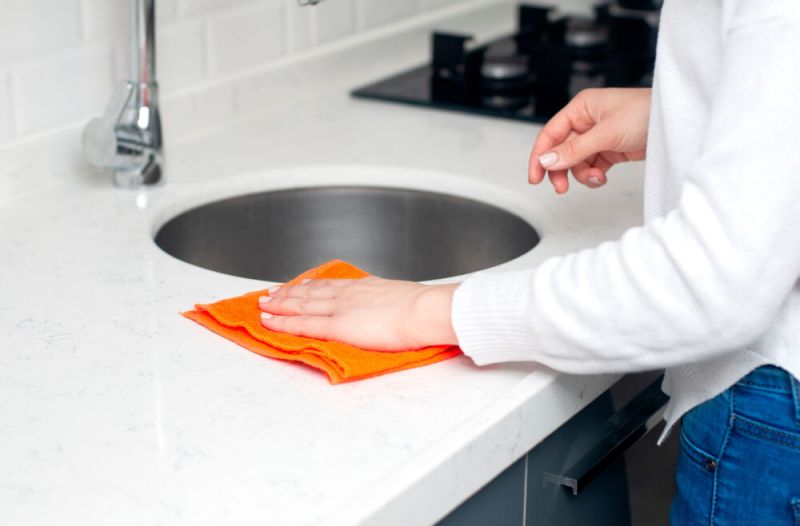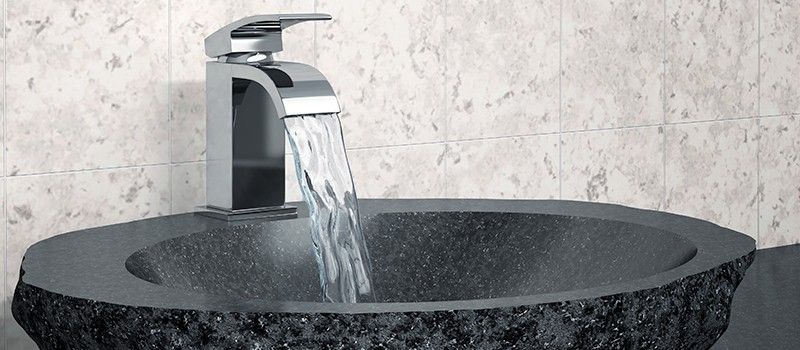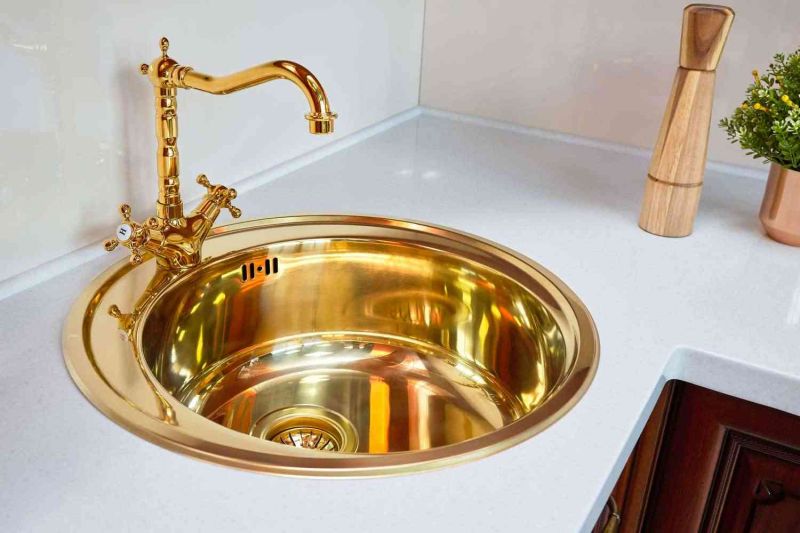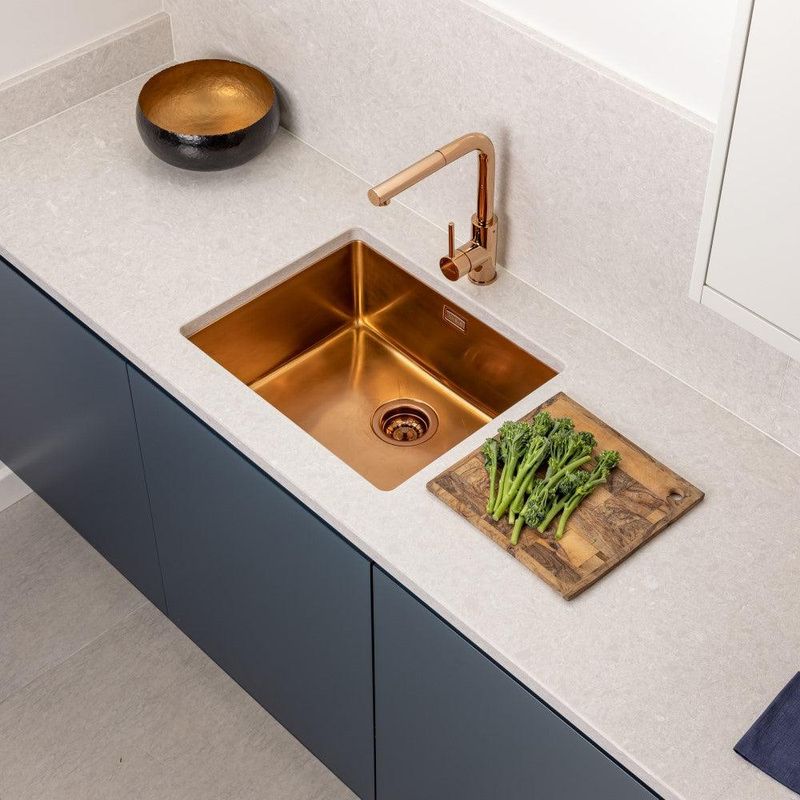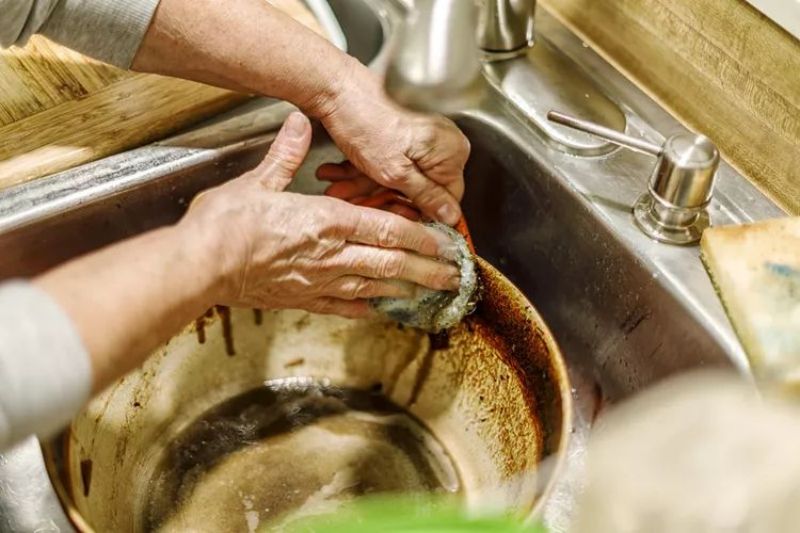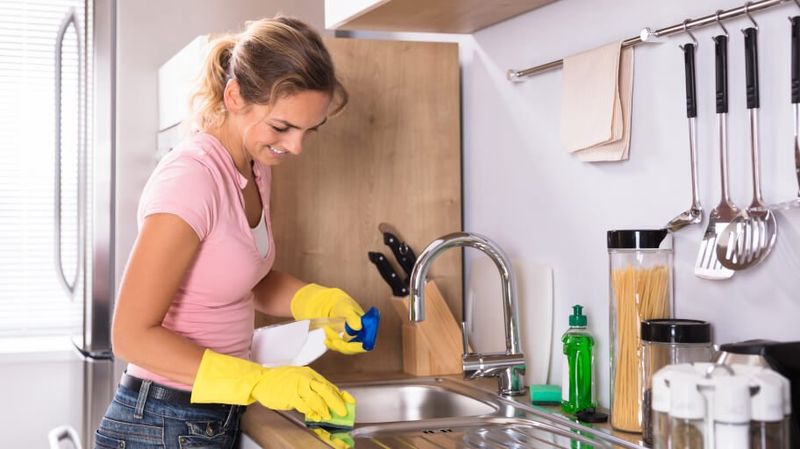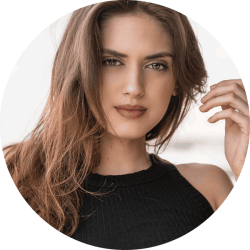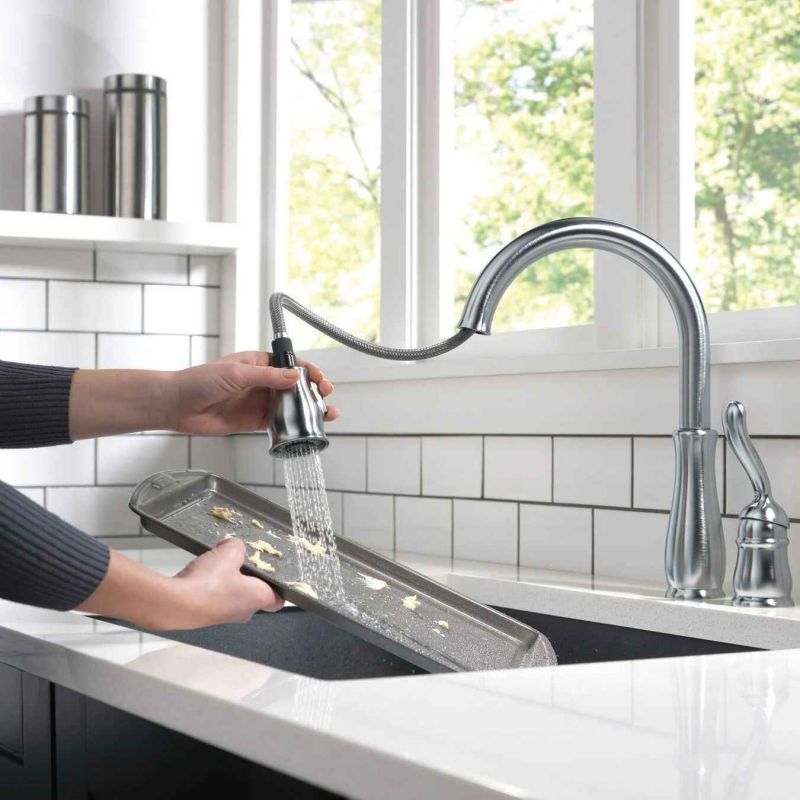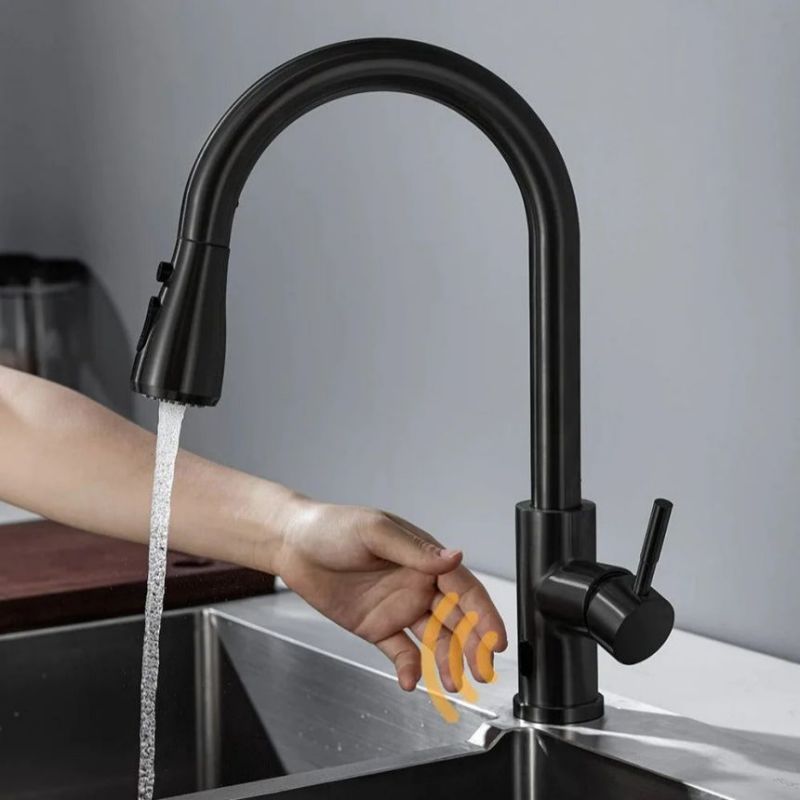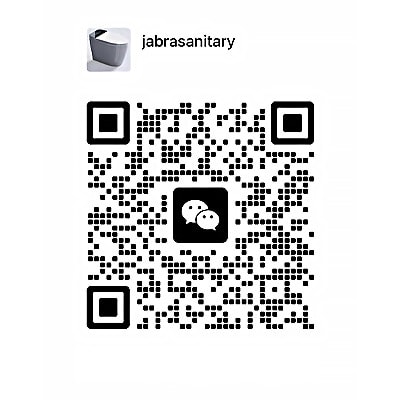 English
English
Jabra Sanitary is a sanitaryware supplier offering toilets, sinks, faucets, bathtubs, etc., at competitive prices. If you're a distributor, wholesaler, or project contractor, get a quote today!
 $23.9 Limited-time Offer
$23.9 Limited-time Offer Consignment Policy
Consignment Policy 20 Years of Experience
20 Years of Experience
Kitchen sinks are one of the most used fixtures in any home, making regular cleaning and maintenance essential. Whether it's a stainless steel sink or ceramic sinks, each kitchen sink material type requires specific care to keep it looking its best. Proper sink care ensures that your sink stays in top condition for years.
In this guide, we will cover how to clean various types of kitchen sink, and offer tips for sink maintenance. By following these steps, you can ensure your kitchen sink stays clean, stain-free, and retains its original shine.
Table of Contents
How to Clean a Kitchen Sink: Dos and Don'ts
How to Clean a Stainless Steel Kitchen Sink
How to Clean a Porcelain Kitchen Sink
How to Clean a Ceramic Kitchen Sink
How to Clean a Composite Kitchen Sink
How to Clean a Resin Kitchen Sink
How to Clean a Granite Kitchen Sink
How to Clean a Marble Kitchen Sink
How to Clean a Stone Kitchen Sink
How to Clean a Copper Kitchen Sink
How to Clean a Brass Kitchen Sink
How to Clean a Bronze Kitchen Sink
How to Care Fireclay Kitchen Sink
How to Clean Enameled Cast Iron Kitchen Sink
Sink Styles and Cleaning Tips
Remember to Clean the Faucet as Well
How to Clean a Kitchen Sink Handle
How to Clean a Kitchen Sink Drain That Smells
Sink Maintenance and Care
How to Clean a Kitchen Sink: Dos and Don'ts
For those wondering how to get stains out of sink, use a mixture of baking soda and water to form a paste, gently scrubbing the stains with a soft cloth. Regular cleaning of the kitchen sink with non-abrasive cleaners can prevent stubborn stains and keep your sink looking pristine.
Dos
- Clean your kitchen sink regularly to prevent buildup and stains.
- Use cleaners appropriate for your sink material to avoid damage.
- Rinse and dry the sink after each use to prevent water spots.
- Use gentle scrubbers like sponges or soft cloths to avoid scratching.
Don'ts
- Avoid using harsh chemicals, as they can damage the sink's finish.
- Do not use abrasive scrubbers like steel wool, which can scratch the surface.
- Never let acidic substances like lemon juice or vinegar sit on the sink surface for too long, especially on stone or metal sinks.
How to Clean a Stainless Steel Kitchen Sink
Stainless steel sinks are popular for their durability and sleek appearance. However, they can show water spots and scratches if not properly cared for. Here's how to clean a stainless steel sink to maintain its shine and prevent damage.
Materials Needed
- Mild dish soap
- Baking soda
- Soft sponge or cloth
- Microfiber cloth
Step-by-Step Cleaning Process
- Rinse the sink with warm water to remove any loose debris.
- Apply a small amount of mild dish soap to a sponge and gently scrub the entire surface of the sink.
- For tougher stains, sprinkle baking soda over the sink and scrub in the direction of the grain with a soft sponge.
- Rinse thoroughly with warm water to remove all soap and baking soda residue.
- Dry the sink with a microfiber cloth to prevent water spots.
Maintenance Tips
- Always dry your stainless steel sink after use to prevent water spots.
- Buff the surface with a microfiber cloth to keep it shiny.
- Avoid leaving metal utensils or cookware in the sink to prevent rust marks.
- Polish the stainless steel to maintain its shine and remove minor scratches.
How to Clean a Porcelain Kitchen Sink
Porcelain sinks are known for their classic, glossy finish, but they can be prone to scratches and stains if not cleaned properly. It's important to use gentle cleaners to maintain the integrity of the surface. If you're wondering how to clean a porcelain kitchen sink or need a good porcelain kitchen sink cleaner, follow these steps.
Materials Needed
- Non-abrasive cleaner (like a baking soda paste or mild dish soap)
- White vinegar
- Soft sponge or cloth
- Microfiber cloth
Step-by-Step Cleaning Process
- Rinse the sink with warm water to remove any loose dirt and debris.
- Apply a non-abrasive cleaner or baking soda paste to the surface of the sink.
- Gently scrub the sink using a soft sponge, focusing on areas with stains. This method works well to clean porcelain kitchen sink without damaging the surface.
- For stubborn stains, spray a bit of white vinegar onto the area and let it sit for a few minutes before scrubbing again.
- Rinse the sink thoroughly with warm water to remove all cleaner residue.
- Dry the sink with a microfiber cloth to prevent water spots.
Tips for Maintaining Porcelain Kitchen Sinks
- Avoid using harsh or abrasive cleaners that can scratch the porcelain surface.
- For deep stains, use a paste of baking soda and water, letting it sit for a few minutes before scrubbing gently.
- Rinse the sink after each use to prevent soap scum buildup.
How to Clean a Ceramic Kitchen Sink
Ceramic sinks are durable and come in a variety of styles. They are generally easy to clean, but it's important to avoid abrasive materials that can damage the glossy finish. Here’s how to clean a ceramic sink properly to maintain its appeal.
Materials Needed
- Mild detergent
- Soft sponge or cloth
- White vinegar (for tough stains)
- Microfiber cloth
Step-by-Step Cleaning Process
- Rinse the sink with warm water to remove any loose particles.
- Apply a small amount of mild detergent to a soft sponge.
- Gently scrub the entire surface of the sink, paying special attention to any stained areas. Cleaning gently ensures you clean a ceramic sink without damaging its glossy finish.
- If you encounter stubborn stains, dampen a cloth with white vinegar and rub the area gently.
- Rinse thoroughly with warm water to remove soap and vinegar residue.
- Dry the sink with a microfiber cloth to maintain its shine.
Maintenance Tips for Ceramic Kitchen Sinks
- Avoid using harsh chemicals and abrasive scrubbers to prevent scratching the surface.
- Regularly rinse and dry the sink to prevent water spots and soap scum.
- Use a mild detergent for daily cleaning to keep the sink looking new.
How to Clean a Composite Kitchen Sink
Composite sinks, made from a blend of materials like quartz and granite, are highly durable and resistant to stains. However, they still require regular care to maintain their appearance. Knowing how to clean a composite sink is key to maintaining its beauty.
Materials Needed
- Gentle dish soap
- Soft scrub brush or sponge
- White vinegar (optional for deep cleaning)
- Microfiber cloth
Step-by-Step Cleaning Process
- Rinse the sink with warm water to remove any debris.
- Apply a few drops of gentle dish soap to a soft scrub brush or sponge.
- Scrub the sink in circular motions, focusing on any stains or discolorations.
- For tougher stains, you can use a mixture of white vinegar and water. Apply it to the stained area and scrub gently.
- Rinse the sink thoroughly with warm water to remove all soap and vinegar residue.
- Dry the sink with a microfiber cloth to prevent water spots and maintain its finish.
Maintenance Tips for Composite Kitchen Sinks
- Avoid using abrasive cleaners or steel wool, as they can scratch the surface.
- Rinse the sink after each use to prevent mineral buildup and stains.
- Wipe down the sink with a soft cloth to keep it looking pristine.
How to Clean a Resin Kitchen Sink
Resin sinks are popular for their glossy finish and durability. They are relatively low maintenance but can be prone to scratching if abrasive materials are used. Proper care ensures their longevity and appearance.
Materials Needed
- Mild soap
- Non-abrasive sponge
- Soft cloth or microfiber towel
Step-by-Step Cleaning Process
- Start by rinsing the sink with warm water to remove loose dirt and debris.
- Apply a small amount of mild soap to a non-abrasive sponge.
- Gently scrub the sink’s surface, making sure to clean around the edges and drain.
- Rinse the sink thoroughly with warm water to wash away soap residue.
- Dry the sink with a soft cloth or microfiber towel to prevent water spots.
Maintenance Tips for Resin Kitchen Sinks
- Avoid using abrasive scrubbers or harsh chemicals that can damage the resin's glossy finish.
- Wipe the sink dry after each use to prevent water spots and mineral deposits.
- Use a mild cleaner regularly to maintain the sink’s appearance.
How to Clean a Granite Kitchen Sink
Granite sinks are both durable and stylish, providing a natural stone look. They require gentle cleaning to prevent damage and maintain their sealant layer. If you're curious about how to clean a stone sink, these steps also apply to granite and similar materials.
Materials Needed
- Warm water
- Baking soda
- Soft sponge or cloth
- Microfiber towel
Step-by-Step Cleaning Process
- Rinse the sink with warm water to remove any loose particles and debris.
- Sprinkle baking soda over the sink’s surface for a gentle abrasive cleaning.
- Use a soft sponge or cloth to scrub the sink in circular motions, focusing on stained or discolored areas.
- Rinse the sink thoroughly with warm water to remove all baking soda.
- Dry the sink with a microfiber towel to avoid water spots and keep the granite looking polished.
Maintenance Tips for Granite Kitchen Sinks
- Avoid using acidic or harsh chemicals as they can damage the granite's sealant.
- Regularly seal the granite sink to protect it from stains and scratches.
- Wipe the sink dry after use to prevent mineral buildup and maintain its shine.
How to Clean a Marble Kitchen Sink
Marble sinks add a touch of luxury to any bathroom or kitchen, but they require special care due to their porous nature. Marble is prone to etching and staining, so using the right cleaning products is crucial.
Materials Needed
- pH-neutral cleaner
- Soft cloth or sponge
- Microfiber towel
Step-by-Step Cleaning Process
- Rinse the sink with warm water to remove surface dirt.
- Apply a pH-neutral cleaner to a soft cloth or sponge. Avoid acidic or abrasive cleaners.
- Gently wipe down the sink, taking care not to scrub too hard, as marble can scratch easily.
- Rinse the sink thoroughly with warm water to remove any cleaner residue.
- Dry the sink with a microfiber towel to prevent water spots and streaks.
Maintenance Tips for Marble Kitchen Sinks
- Avoid using vinegar, lemon juice, or any acidic cleaner on marble, as it can cause etching.
- Seal the marble sink regularly to protect it from stains and etching.
- Wipe up spills immediately, especially those from acidic substances like wine or citrus, to prevent stains.
How to Clean a Stone Kitchen Sink
Stone sinks, like those made from granite, marble, or soapstone, provide a natural and elegant look. Proper care is necessary to maintain their beauty, as they can be prone to stains and scratches if not cleaned correctly. Knowing how to clean a stone sink properly ensures it lasts longer and looks great.
Materials Needed
- Mild dish soap
- Soft sponge or cloth
- Microfiber towel
Step-by-Step Cleaning Process
- Rinse the sink with warm water to remove any loose debris.
- Apply a small amount of mild dish soap to a soft sponge.
- Gently scrub the surface of the sink, paying attention to any stains or discolorations.
- Rinse thoroughly with warm water to remove all soap residue.
- Dry the sink with a microfiber towel to prevent water spots.
Maintenance Tips for Stone Sinks
- Avoid using harsh or acidic cleaners that can damage the stone's surface.
- Regularly seal stone sinks to protect them from stains and water damage.
- Wipe the sink dry after use to prevent mineral buildup.
How to Clean a Copper Kitchen Sink
Copper sinks are known for their unique patina and warmth. Over time, they can develop a natural, aged look, but regular cleaning can help maintain their shine. Understanding how to clean copper sink with baking soda is key to keeping it in top condition.
Materials Needed
- Baking soda
- Lemon (optional)
- Soft sponge or cloth
- Microfiber towel
Step-by-Step Cleaning Process
- Rinse the sink with warm water to remove any surface dirt.
- Sprinkle baking soda over the sink's surface, focusing on stained or tarnished areas.
- If desired, cut a lemon in half and use it to scrub the baking soda into the sink. The natural acidity of the lemon helps break down tarnish.
- Use a soft sponge to gently scrub the sink in circular motions.
- Rinse thoroughly with warm water to remove all baking soda and lemon residue.
- Dry the sink with a microfiber towel to prevent water spots and maintain its shine.
Maintenance Tips for Copper Sinks
- Avoid using harsh chemicals or abrasive scrubbers that can scratch the copper's surface.
- Allow the sink to develop a natural patina for a unique, aged look, or use a copper polish to maintain a bright shine.
- Wipe the sink dry after each use to prevent water spots and mineral buildup.
How to Clean a Brass Kitchen Sink
Brass sinks add a touch of luxury and sophistication to any space. To maintain their luster and prevent tarnish, it's important to clean them properly using gentle methods. If you want to know how to clean brass sink without damaging it, follow this process.
Materials Needed
- Mild dish soap
- White vinegar
- Soft sponge or cloth
- Microfiber towel
Step-by-Step Cleaning Process
- Rinse the sink with warm water to remove any loose dirt and debris.
- Apply a few drops of mild dish soap to a soft sponge and gently scrub the surface.
- For tougher stains or tarnish, mix equal parts white vinegar and water, then dampen a cloth with the mixture and rub the area gently.
- Rinse the sink thoroughly with warm water to remove soap and vinegar residue.
- Dry the sink with a microfiber towel to prevent water spots and maintain its shine.
Maintenance Tips for Brass Sinks
- Avoid using harsh chemicals or abrasive scrubbers that can damage the brass finish.
- Regularly polish the brass with a specialized cleaner to maintain its luster.
- Dry the sink after each use to prevent water spots and keep it looking its best.
How to Clean a Bronze Kitchen Sink
Bronze sinks offer a rustic, antique appeal and develop a unique patina over time. While the patina adds character, proper cleaning is essential to maintain the sink's appearance and prevent unwanted tarnish.
Materials Needed
- Warm water
- Mild soap
- Soft sponge or cloth
- Microfiber towel
Step-by-Step Cleaning Process
- Rinse the sink with warm water to remove any debris.
- Apply a small amount of mild soap to a soft sponge or cloth.
- Gently scrub the sink’s surface, focusing on any areas with residue or stains.
- Rinse thoroughly with warm water to remove soap residue.
- Dry the sink with a microfiber towel to prevent water spots and preserve the patina.
Maintenance Tips for Bronze Sinks
- Avoid using harsh chemicals or abrasive scrubbers that can damage the bronze surface.
- Embrace the natural patina that develops over time, as it adds to the sink’s unique charm.
- Wipe the sink dry after each use to prevent water spots and mineral deposits.
How to Care Fireclay Kitchen Sink
Fireclay sinks are known for their durability and resistance to scratches and stains. However, they still require regular cleaning to maintain their smooth, glossy finish. Proper care can help prevent chips and preserve the sink's appearance.
Materials Needed
- Non-abrasive cleaner
- Soft sponge or cloth
- Microfiber towel
Step-by-Step Cleaning Process
- Rinse the sink with warm water to remove any loose debris.
- Apply a non-abrasive cleaner to a soft sponge or cloth.
- Gently scrub the sink, focusing on areas with stains or residue.
- Rinse thoroughly with warm water to remove all cleaner residue.
- Dry the sink with a microfiber towel to maintain its glossy finish.
Maintenance Tips for Fireclay Sinks
- Avoid using abrasive cleaners or scrubbers that can scratch or dull the surface.
- Place a sink mat at the bottom to protect against heavy pots or sharp utensils that might cause chips.
- Wipe the sink dry after use to prevent water spots and keep it looking new.
How to Clean Enameled Cast Iron Kitchen Sink
Enameled cast iron sinks are prized for their strength and classic look. However, the enamel coating can be prone to chipping if not properly maintained. Regular cleaning helps preserve the enamel and prevent stains.
Materials Needed
- Mild dish soap
- Soft sponge or cloth
- Microfiber towel
Step-by-Step Cleaning Process
- Rinse the sink with warm water to remove any debris or residue.
- Apply a small amount of mild dish soap to a soft sponge.
- Gently scrub the sink’s surface, paying attention to stained areas.
- Rinse thoroughly with warm water to remove soap residue.
- Dry the sink with a microfiber towel to prevent water spots and maintain the enamel’s shine.
Maintenance Tips for Enameled Cast Iron Sinks
- Avoid using abrasive scrubbers or harsh chemicals that can scratch or dull the enamel surface.
- Use a sink mat or dish rack to protect the enamel from heavy or sharp objects.
- Regularly rinse and dry the sink to prevent mineral buildup and staining.
Sink Styles and Cleaning Tips
Different sink types, such as countertop, undermount, and vessel sinks, require specific cleaning techniques depending on their installation and material. Proper cleaning and maintenance ensure these sinks stay functional and attractive.
Countertop Sinks
- Wipe down the surrounding countertop with a mild cleaner to prevent water stains and soap buildup.
- Regularly check the caulking around the sink to ensure it's intact and preventing leaks.
- Clean the sink basin following the material-specific instructions, whether it's porcelain, stainless steel, or another material.
Undermount Sinks
- Pay special attention to the edges where the sink meets the countertop, as dirt and grime can accumulate here.
- Use a toothbrush or small brush to clean the seam where the sink and countertop join.
- Ensure the seal between the sink and countertop remains watertight to prevent water damage.
Vessel Sinks
- Clean the outside and inside of the sink bowl to maintain its appearance.
- Avoid using abrasive scrubbers on the vessel sink's exterior, especially if it's made of glass or delicate materials.
- Regularly clean the countertop around the vessel sink to prevent water stains.
Remember to Clean the Faucet as Well
Cleaning the sink is only part of the task. Kitchen faucets can accumulate water spots, mineral deposits, and soap scum over time. Keeping them clean ensures a fully polished and hygienic sink area.
Materials Needed
- Mild dish soap or vinegar
- Soft cloth or sponge
- Old toothbrush (for detailed cleaning)
- Microfiber towel
Cleaning Process
- Wipe the faucet with a damp cloth to remove loose dirt and debris.
- Mix a small amount of mild dish soap with warm water, then use a cloth or sponge to clean the faucet.
- For tough water spots or mineral deposits, dampen a cloth with white vinegar and wrap it around the faucet. Let it sit for a few minutes before wiping it clean.
- Use an old toothbrush to scrub around the base of the faucet and in any crevices.
- Rinse with clean water and dry the faucet with a microfiber towel to prevent water spots.
How to Clean a Kitchen Sink Handle
Sink handles are often overlooked during cleaning, but they can accumulate grime, soap scum, and even bacteria. Regularly cleaning the sink handles not only keeps them looking shiny but also ensures a hygienic sink area.
Materials Needed
- Mild dish soap or vinegar
- Soft cloth or sponge
- Old toothbrush (for detailed cleaning)
- Microfiber towel
Step-by-Step Cleaning Process
- Begin by wiping the sink handle with a damp cloth to remove surface dirt and dust.
- Mix a small amount of mild dish soap with warm water, or use a solution of equal parts water and vinegar for tougher grime.
- Dip a soft cloth or sponge into the cleaning solution and gently scrub the handle, focusing on areas with visible buildup.
- For hard-to-reach areas, such as around the base of the handle or any crevices, use an old toothbrush to scrub away dirt and residue.
- Rinse the handle with clean water to remove any soap or vinegar residue.
- Dry the handle with a microfiber towel to prevent water spots and keep it looking polished.
Maintenance Tips
- Wipe the sink handle after each use to prevent soap scum and water stains from building up.
- Regularly disinfect the handle, especially in high-use areas, to keep it hygienic.
- Avoid using abrasive cleaners or scrubbers that can scratch the handle's finish.
How to Clean a Kitchen Sink Drain That Smells
A smelly kitchen sink drain can be unpleasant and is usually caused by a buildup of food particles, grease, and bacteria. Cleaning the drain not only removes odors but also helps prevent clogs and maintains a fresh-smelling kitchen.
Materials Needed
- Baking soda
- White vinegar
- Boiling water
- Lemon or essential oils (optional for added freshness)
Step-by-Step Cleaning Process
- Remove any visible debris from the drain, such as food particles or gunk, using a pair of tongs or a drain brush.
- Pour about half a cup of baking soda directly into the drain.
- Follow the baking soda with one cup of white vinegar. The mixture will fizz and bubble, helping to break down grime and neutralize odors.
- Let the baking soda and vinegar sit in the drain for about 10-15 minutes to work their magic.
- Boil a kettle of water. After the waiting period, carefully pour the boiling water down the drain to flush away any loosened debris and the cleaning mixture.
- For added freshness, you can drop a few lemon slices or a few drops of essential oils like lemon or tea tree into the drain and rinse with warm water.
Maintenance Tips
- Regularly flush the drain with boiling water to prevent grease and grime buildup.
- Avoid putting large food scraps or grease down the drain to prevent clogs and odors.
- Use a drain cover to catch food particles and debris before they enter the drain.
Sink Maintenance and Care
Regular maintenance is key to prolonging the life of your sink and keeping it looking its best. Simple daily and weekly routines can prevent stains, scratches, and buildup. Proper sink maintenance ensures long-lasting beauty and functionality.
Routine Cleaning Schedule
- Daily: Rinse the sink after each use to remove soap residue and food particles. Wipe it dry to prevent water spots.
- Weekly: Deep clean your sink with a material-appropriate cleaner. Pay extra attention to areas around the drain and faucet.
- Monthly: Check for any signs of wear, such as chips or cracks, and address them promptly to prevent further damage.
General Maintenance Tips
- Use a sink mat or grid to protect the bottom from scratches and stains.
- Regularly check and replace any worn or damaged parts, such as caulking or seals, to prevent leaks. <Check how to replace a kitchen faucet>
- Avoid leaving acidic substances like vinegar or citrus in contact with the sink surface for extended periods, as they can cause damage.
Final Thoughts
Proper sink care is essential for maintaining both the functionality and appearance of your kitchen. By following the cleaning methods and maintenance tips outlined in this guide, you can keep your kitchen sink looking its best, regardless of its material.
Regular cleaning, appropriate product use, and routine maintenance will ensure your kitchen sink remains a beautiful and durable fixture in your home for years to come. Remember to follow the kitchen sink manufacturer like Jabra Sanitary's maintenance guidelines.







